Parking Garages
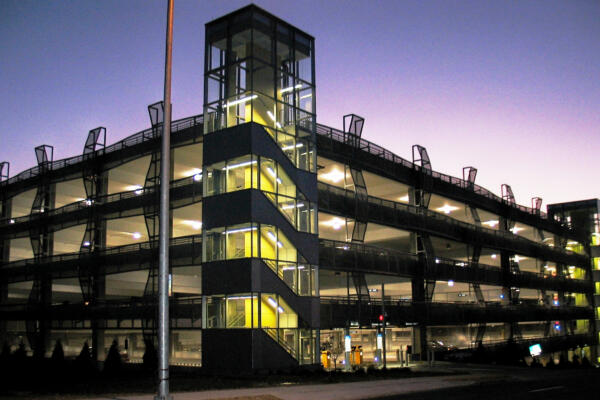
In 2007, the United States registered more than 250 million passenger vehicles, a number that has consistently grown every year since 1960. To accommodate this growing number of vehicles, 6% of the constructed square footage in the United States was comprised of parking facilities. In an age of environmental consciousness, however, there is more to parking cars than the gratification of a need.
When approaching the materials and design of a parking garage, specifiers should examine how the new structure will affect the surrounding society, both immediately and into the future. When planning a parking structure, it is critical to address the elements of sustainable design, such as in the NREL Garage in Golden, Colorado.
The client and community require a structure that services many needs; the project must be attractive, well designed, economical, and structurally sound, as well as provide users with seamless service, functionality, and a source of pride for the community. Using hot-dip galvanized steel as the core frame of a new parking garage, designers can address these needs by providing the following benefits.
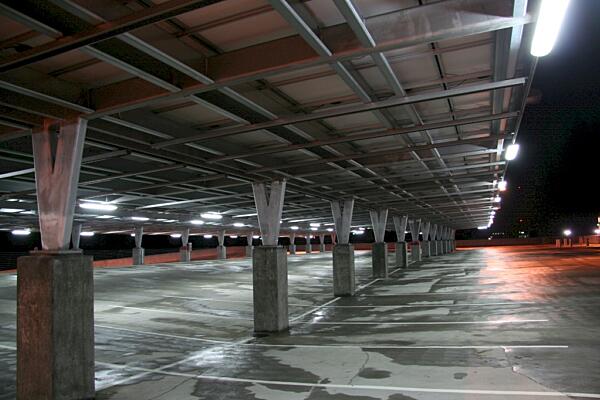
Steel structures afford more options for member shape and façade design, meaning the designer can create a structure that is pleasing to the eye and attractive to the community. Using slender, strong galvanized steel beams means your garage will have better lighting, contributing to an open, safer ambiance for users. Also, the slender steel elements will take up less usable space within the structure.
With quick turnover and construction, using a steel frame means the garage will be up and running in short order and cars will be filling the garage in no time. By creating more with less; more design options, more flexibility for the future with less material; a hot-dip galvanized steel framing system creates a beautiful, functional structure that will stand the test of time, while simultaneously embracing the statutes of sustainable development a social, economic, and environmental approach to design.
More With Less
At every stage of construction, a hot-dip galvanized steel parking garage gives the consumer more: more design flexibility, more parking spaces, more options for future expansion, and more corrosion protection. In the initial design phase, clients must examine which type of structures grant the most options to get the job done efficiently and economically. Utilizing a steel framing system, specifiers can choose the most advantageous decking system from any of the three major categories: precast systems, cast-in-place floor slabs, or cast-in-place post-tensioned floor slabs. Other framing systems will limit the choice of decking.
More Design Freedom
Incorporating hot-dip galvanized steel into a structure can unlock a range of design possibilities affecting both beauty and functionality. Not limited by the weight and constraints of concrete exteriors, steel façade elements can take on a variety of appearances. Features such as streamlined steel cable supports; sleek, modern railings; elaborate decorative paneling, and more can all be incorporated to complement the structure of the facility. The Cincinnati Children's Hospital Garage incorporates a series of undulating, wavy galvanized steel façade elements to enhance its appearance.
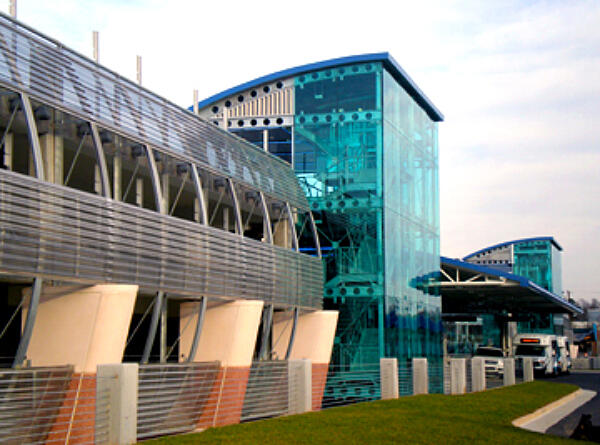
Not only can a wide array of designs and façades be easily attached to the steel structure, the steel itself can be arched and bent into striking shapes. The Charlotte Douglas International Airport Parking Garage features a unique convex exterior façade reminiscent of the curvature of an airplane wing. Similarly, the exposed parking canopy, spiral staircase, façade supports, and other elements of the Arizona State University Garage are fit for center stage. Galvanized steel allowed for exceptional styling of these typically boring elements, creating a striking welcome to all who enter.
More Space
Utilizing slim, strong steel structural elements will result in more usable space within a parking garage. The interior layout of a garage can take advantage of the lightweight flexibility of exposed galvanized steel beams. With slender beams carrying the weight of the garage on fewer, narrower columns, the designer will be able to fit more parking spaces into the same ground footprint. Steel columns require 80% less floor space than equivalent concrete columns, increasing the usable floor area of the garage and decreasing the average cost-per-space. Bulky concrete supports and shear walls take away from usable space, while steel capitalizes on it. One of the most efficient ways to capitalize on materials and space is by working with castellated beams.
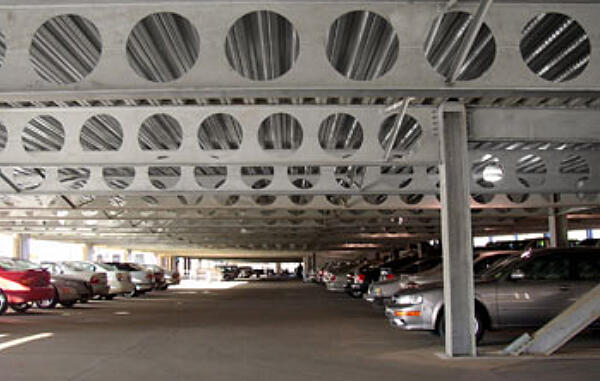
Castellated (or cellular) beams increase the efficiency of a single piece of steel. As seen in the image to the left, one steel beam is cut into either a toothed or circular pattern lengthwise, separated, offset, and then rejoined into one cohesive piece. The resulting beam is not only lighter but also 50% stronger than the original beam, maximizing the potential of a single piece of steel. Generally, the weight savings when castellated beams are utilized in a complete structure is 20 - 50%.
There are many implications for utilizing a weight-bearing, lightweight structural element like castellated beams. The increased strength of the castellated supports will allow for the possibility of more vertical stories and greater weight capacity per floor, meaning greater vehicle capacity for the garage. With more room for spaces, specifiers can either opt to take advantage of additional parking in the same amount of space or choose to decrease the size of the garage to achieve the desired number of parking spaces, reducing both the size and cost of the structure.
Castellated beams also positively affect floor-to-floor height. The many mechanical, electrical, and fire protection systems required inside of the structure take up additional space when using impenetrable concrete framing. With castellated beams, such systems can be woven through the holes and openings to make efficient use of space, decreasing the necessary floor-to-floor height. The Ayrsley Parking Garage takes advantage of the added strength and support provided by castellated beams.
More Structural Safety
Hot-dip galvanized steel framing systems not only develop visibility and the appearance and feeling of safety in a garage, they also can provide seismic advantages. Steel framing structures are more seismic resistant than concrete frames due to the ductile, adaptable steel members. Able to bend within reason without breaking, the tensile strength of a steel structure can protect a garage from damage during seismic activity, protecting the builder's investment, and more importantly, the cars and people sheltered within.
Speedier Construction
There are two primary structural systems that come together to form a parking garage: the framing system and the deck system. According to Innovative Solutions in Steel: Open-Deck Parking Structures, the occupancy date of a parking structure is often governed by the completion of these two systems. The quickest route to a packed parking garage is the fast erection time and quick turnaround provided by a hot-dip galvanized steel framing system.
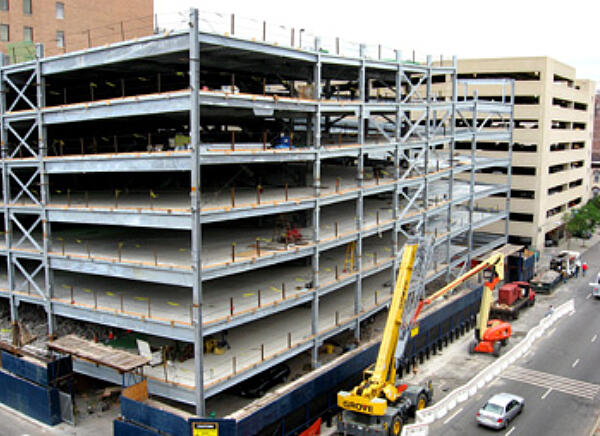
Several elements contribute to a steel framed structure scoring the fastest erection time compared to other systems. Steel beams are fabricated offsite and delivered to the site ready for construction. Because steel members have a high strength-to-weight ratio, these pieces prove more maneuverable onsite. Smaller parts mean the elements arrive onsite quickly without the difficulties or delays posed by locations with limited delivery/construction access. They slip onsite, ready to be swooped up and rapidly, efficiently placed by a crane.
The hot-dip galvanizing process works swiftly and seamlessly into the assembly progression. After the steel members are fabricated, they are sent to the galvanizing plant. As the galvanizing process is completed at an indoor facility, there are no hindrances due to inclement weather. The pieces are in and out of the galvanizing plant, then promptly delivered to the site. With the swift turnover of these elements, builders are measuring completion times in weeks, not months.
More Expansion Options
A lean, sturdy steel core frame is the ideal setup for expansion. As the American Institute of Steel Construction (AISC) states in Open Deck Parking Structures, vertical expansion can be easily accomplished in a steel-framed structure through the splicing of existing columns and the placement of steel members with readily available cranes. The most flexible option for vertical development, additional steel reinforcement will couple easily with the original design and will take fewer pieces to support the weight of new parking tiers. By using techniques such as welding, bolting and splicing of existing columns, a steel framing system is easily adaptable to vertical expansion, or even space adaptation. With fewer, lighter pieces required and assembly techniques that can solve problems onsite, steel gives the designer more flexibility to negotiate problem areas and develop effective solutions for expansion.
Additionally, expansion of a steel frame will have less impact on the day-to-day functionality of the garage. Often times, only the top-most parking tier needs to be taken out of commission to facilitate the upward growth of the structure. Fewer cars will be inconvenienced, and, for the most part, business can continue as usual with the least interruption of service until the new tiers are unveiled. With procedures that will not take the entire garage out of commission for updating or expansion, a hot-dip galvanized steel frame will unlock new possibilities for the future.
Parking Garage Case Study
Charlotte Douglas International Airport Garage- Charlotte, NC; 2005
The Charlotte Douglas International Airport, with an average of 600 daily departures, is a rapidly growing airport in the southeastern United States. As the passenger traffic has increased over the past few years, so has the demand for more parking. In late 2004, the airport broke ground to being construction on a 3,000 space parking facility to increase customer-parking capacity by 13 percent. The designer wanted to break away from the normal square, concrete box structure of parking facilities and envisioned a facility that would mirror the curvature of an airplane wing.
